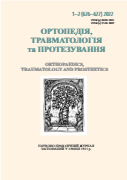Acetabulum fractures. Analysis of treatment results
DOI:
https://doi.org/10.15674/0030-598720221-277-84Keywords:
Acetabulum fractures, ostheosynthesis, primary total hip replacement, posttraumatic coxarthrosisAbstract
Treatment of patients with acetabulum fractures (AF) remains a big challenge for orthopaedists and traumatologists. Such
fractures are known for their complications that lead to disability. Objective. To analyze the results of treatment of patients
with AF and complications that arise depending on the of the injury mechanism and the method of treatment, to evaluate the effectiveness available methods of preventing the development of these complications. Methods. A retrospective study was
done on the basis of 89 AF patients analysis (age 17‒75 years, 22 women and 67 men) with different terms after the fracture.
The majority of patients got primary care in other clinics. Diagnostic measures: clinical examination; X-ray examination
of the pelvis, that under conditions of acute injuries were supplemented with CT scan; ultrasound of abdominal cavity,
chest X-ray, brain MRI, electroneuromyography of the lower limbs. Results. Most AF occurred as a result of traffic accidents.
The most common types are A1 and B1 according to the classification of AO/ASIF. The system of skeletal traction has been
applied often at the stage of primary treatment. During surgical treatment the Kocher-Langenbeck approach and osteosynthesis was mainly used to stabilize the posterior wall and acetabulum column. The typical complications of AF are coxarthrosis, femoral head aseptic necrosis despite the chosen treatment tactics. Their clinical manifestation with the hip impaired function occurred within a year after the trauma. Defined complications led to the need for total hip replacement in 67 (75.3 %) cases out of 89. In 8 patients, total hip replacement was performed in the acute period of injury and it was possible to restore the joint function with better early functional results compared to the rest of the patients. Conclusions. Primary total hip replacement in the case of AF is an effective treatment measure that gives the posibility restore the function of the hip joint in the shortest time and prevent the development of typical complications.
References
- Melhem, E., Riouallon, G., Habboubi, K., Gabbas, M., & Jouffroy, P. (2020). Epidemiology of pelvic and acetabular fractures in France. Orthopaedics & Traumatology: Surgery & Research, 106(5), 831-839. doi:10.1016/j.otsr.2019.11.019
- Nicol, G. M., Sanders, E. B., Kim, P. R., Beaulé, P. E., Gofton, W. T., & Grammatopoulos, G. (2021). Outcomes of total hip arthroplasty after acetabular open reduction and internal fixation in the elderly—Acute vs delayed total hip arthroplasty. The Journal of Arthroplasty, 36(2), 605-611. doi:10.1016/j.arth.2020.08.022
- Kim, J. W., Herbert, B., Hao, J., Min, W., Ziran, B. H., & Mauffrey, C. (2015). Acetabular fractures in elderly patients: A comparative study of low-energy versus high-energy injuries. International Orthopaedics, 39(6), 1175-1179. doi:10.1007/s00264-015-2711-0
- Zhigun, А. I. (2010). Consequences of acetabulum fractures: prediction, diagnostics, treatment (clinico-experimental research) (Tesis ... doctor of medical scienses) (in russian)
- Ziran, N., Soles, G. L., & Matta, J. M. (2019). Outcomes after surgical treatment of acetabular fractures: A review. Patient Safety in Surgery, 13(1). doi:10.1186/s13037-019-0196-2
- Poletti, P., Sahin, M., Peter, R., Boudabbous, S., Herpe, G., Rutschmann, O. T., & Platon, A. (2018). Femoral head subchondral impaction on CT: What does it mean in patients with acetabular fracture? Skeletal Radiology, 48(6), 939-948. doi:10.1007/s00256-018-3100-8
- Haidukewych, G. J., Scaduto, J., Herscovici, D., Sanders, R. W., & DiPasquale, T. (2002). Iatrogenic nerve injury in acetabular fracture surgery: A comparison of monitored and unmonitored procedures. Journal of Orthopaedic Trauma, 16(5), 297-301. doi:10.1097/00005131-200205000-00002
- Tile, M., Helfet, D. L., & Kellam, J. F. (2015). Fractures of the pelvis and acetabulum: Principles and methods of management. Thieme, AO Foundation.
- Ugino, F. K., Righetti, C. M., Alves, D. P., Guimarães, R. P., Honda, E. K., & Ono, N. K. (2012). Avaliação Da confiabilidade do Método Merle d'Aubigné E Postel Modificado. Acta Ortopédica Brasileira, 20(4), 213-217. doi:10.1590/s1413-78522012000400004
- Apivatthakakul, T., Koerner, J. L., Luangsod, S., Buranaphatthana, T., Parry, J., Hadeed, M., … Mauffrey, C. (2021). Size and location of posterior wall fragment on CT can predict hip instability in a cadaveric model. Injury, 52(8), 2104-2110. doi:10.1016/j.injury.2021.03.041
- Johannsen, A. M., Ejnisman, L., Behn, A. W., Shibata, K., Thio, T., & Safran, M. R. (2019). Contributions of the capsule and Labrum to hip mechanics in the context of hip Microinstability. Orthopaedic Journal of Sports Medicine, 7(12), 232596711989084. doi:10.1177/2325967119890846
- JUDET, R., JUDET, J., & LETOURNEL, E. (1964). Fractures of the acetabulum. The Journal of Bone & Joint Surgery, 46(8), 1615-1675. doi:10.2106/00004623-196446080-00001
- Ryan, S. P., Manson, T. T., Sciadini, M. F., Nascone, J. W., LeBrun, C. T., Castillo, R. C., … O'Toole, R. V. (2017). Functional outcomes of elderly patients with Nonoperatively treated acetabular fractures that meet operative criteria. Journal of Orthopaedic Trauma, 31(12), 644-649. doi:10.1097/bot.0000000000000990
Downloads
How to Cite
Issue
Section
License

This work is licensed under a Creative Commons Attribution 4.0 International License.
The authors retain the right of authorship of their manuscript and pass the journal the right of the first publication of this article, which automatically become available from the date of publication under the terms of Creative Commons Attribution License, which allows others to freely distribute the published manuscript with mandatory linking to authors of the original research and the first publication of this one in this journal.
Authors have the right to enter into a separate supplemental agreement on the additional non-exclusive distribution of manuscript in the form in which it was published by the journal (i.e. to put work in electronic storage of an institution or publish as a part of the book) while maintaining the reference to the first publication of the manuscript in this journal.
The editorial policy of the journal allows authors and encourages manuscript accommodation online (i.e. in storage of an institution or on the personal websites) as before submission of the manuscript to the editorial office, and during its editorial processing because it contributes to productive scientific discussion and positively affects the efficiency and dynamics of the published manuscript citation (see The Effect of Open Access).














